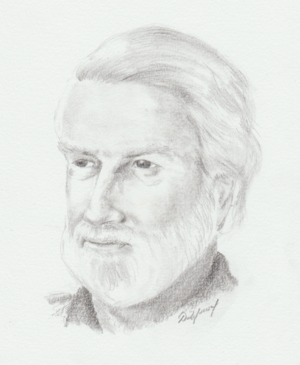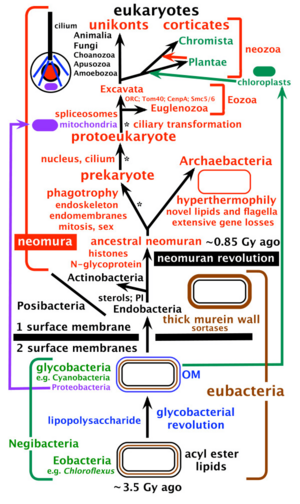Thomas Cavalier-Smith facts for kids
Quick facts for kids
Thomas Cavalier-Smith
|
|
|---|---|
 |
|
| Born | 21 October 1942 London, United Kingdom
|
| Died | 19 March 2021 (aged 78) |
| Nationality | British |
| Alma mater | Gonville and Caius College Cambridge, King's College London |
| Known for | Cavalier-Smith's system of classification of all organisms |
| Awards | Fellow of the Royal Society (1998) International Prize for Biology (2004) The Linnean Medal (2007) Frink Medal (2007) |
| Scientific career | |
| Fields | Zoology |
| Institutions | King's College London, University of British Columbia, University of Oxford |
| Thesis | Organelle Development in Chlamydomonas reinhardii' (1967) |
Thomas (Tom) Cavalier-Smith (born October 21, 1942 – died March 19, 2021) was a British professor. He taught evolutionary biology at the University of Oxford.
He was famous for discovering many tiny living things called protists. He also created new ways to group all living organisms. These groups include Chromista, Chromalveolata, Opisthokonta, Rhizaria, and Excavata.
Contents
A Life in Science
Thomas Cavalier-Smith was born in London on October 21, 1942. His parents were Mary Maude and Alan Hailes Spencer Cavalier Smith.
He went to Norwich School. Then he studied at Gonville and Caius College, Cambridge and King's College London. He earned his PhD in 1967. His research was about how tiny parts of cells grow in a type of green algae.
From 1967 to 1969, he worked as a guest researcher at Rockefeller University. In 1969, he became a teacher of biophysics at King's College London. He became a Reader (a senior academic position) in 1982.
In 1989, he became a Professor of Botany at the University of British Columbia. Later, in 1999, he moved to the University of Oxford. He became a Professor of evolutionary biology there in 2000.
Thomas Cavalier-Smith passed away in March 2021 after battling cancer.
How Life is Grouped: Cavalier-Smith's Ideas
Cavalier-Smith spent his career studying how to group all living things. This is called taxonomy. He looked at a lot of information to suggest new ways that living things might be related.
He often created new names for these groups. Sometimes, he used old names but gave them new meanings. His goal was to show how different life forms evolved from common ancestors.
One of his big ideas was about a group called Chromista. He thought that all Chromista got their special chlorophyll (which helps plants make food) from one single event long ago. This idea was debated by other scientists.
Cavalier-Smith wrote many papers about how to classify all life forms. He focused a lot on protists, which are tiny, single-celled organisms. He suggested a new kingdom of life called the Chromista. However, not all scientists agree that this group is related in the way he suggested.
He also introduced other new groups for eukaryotes. Eukaryotes are living things whose cells have a nucleus. These groups include Chromalveolata (1981), Opisthokonta (1987), Rhizaria (2002), and Excavata (2002). His ideas were often discussed and sometimes controversial.
Eight Kingdoms Model
Cavalier-Smith first suggested a major classification system in 1981. He thought there should be eight kingdoms of life. This was a change from the five-kingdom system that was popular at the time.
His first eight kingdoms were: Bacteria, Eufungi, Ciliofungi, Animalia, Biliphyta, Viridiplantae, Cryptophyta, and Euglenozoa.
In 1983, he updated his system. He included a new group called Archaebacteria, which are very old types of bacteria. He also added a kingdom called Archezoa for some tiny organisms that seemed to lack mitochondria. Mitochondria are like the powerhouses of cells. Scientists later found that these Archezoa actually did have mitochondria, so this kingdom was eventually removed.
By 1993, his eight kingdoms were: Eubacteria, Archaebacteria, Archezoa, Protozoa, Chromista, Plantae, Fungi, and Animalia.
Six Kingdoms Model
By 1998, Cavalier-Smith simplified his system to six kingdoms. These were: Animalia (animals), Protozoa (some single-celled organisms), Fungi (mushrooms and molds), Plantae (plants, including algae), Chromista, and Bacteria.
In this system, five of his kingdoms were eukaryotes. The main groups were:
- Eubacteria (true bacteria)
- Neomura (a group that includes Archaebacteria and Eukaryotes)
He also created new groups within the animal kingdom. For example, he made three new animal phyla: Acanthognatha, Brachiozoa, and Lobopoda.
Seven Kingdoms Model
In 2015, Cavalier-Smith and his team updated their classification again. They went back to dividing prokaryotes (simple cells without a nucleus) into two kingdoms: Bacteria and Archaea. So, their system then had seven kingdoms in total.
The Root of the Tree of Life
In 2006, Cavalier-Smith suggested what the very first common ancestor of all life might have been. He thought it was a type of bacterium with two cell membranes. This bacterium did not have a flagellum (a tail-like structure for movement).
Awards and Honours
Thomas Cavalier-Smith received many awards for his important work.
He became a Fellow of the Linnean Society of London in 1980. He also became a Fellow of the Royal Society of London in 1998. This is a very high honor for scientists in the UK.
In 2004, he received the International Prize for Biology from the Emperor of Japan. In 2007, he was awarded the Linnean Medal for Zoology. He also won the Frink Medal from the Zoological Society of London in 2007.


